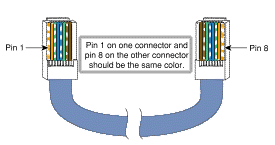BACK
Router User InterfaceThe Cisco Internetwork Operating System (IOS) is the kernel of Cisco's Routers and most of their switches. Cisco IOS software is used to :
The IOS can be accessed through the console port, from a modem (auxiliary port), or through the network via telnet. Access to the IOS command line is called an EXEC session. Console Port
Auxiliary Port
Telnet
Powering up a Cisco Router
SETUP ModeSetup mode has two modes, Basic Management and Extended Setup.
Command Line InterfaceIf you choose to skip setup mode, you will be taken to the command line and the status of all the interfaces will be shown to the screen. Logging in to the RouterDepending on the port you're using, you might have to press enter to get the prompt to appear (console port). The first prompt will look like Routername> the greater than sign at the prompt tells you that you are in user mode. In user mode you can only view limited statistics of the router. To change configurations you first need to enter privileged EXEC mode. This is done by typing enable at the Routername> prompt, the prompt then changes to Routername#. This mode supports testing commands, debugging commands, and commands to manage the router configuration files. To go back to user mode type disable at the Routername# prompt. If you want to leave completely, type logout at the user mode prompt. You can also exit from the router while in privileged mode by typing exit or logout at the Routername# prompt. Global Configuration ModeEnter this mode from the privileged mode by typing configure terminal or conf t for short, the prompt will change to Routername(config)#. Changes made in this mode change the running-config file in DRAM. Use configure memory to change the startup-config in NVRAM. Using configure network allows you to change the configuration file on a TFTP server. If you change the memory or network config files, the router has to put them into memory (DRAM) in order to work with them, so this will change your router's current running-config file. InterfacesWhile in global configuration mode you can enter interface configuration mode and make changes to individual interfaces with the command Router(config)#interface ethernet 0 or
Router(config)#int e0 for short, this enters into the interface configuration mode for Ethernet port 0 and changes the prompt to look like In global configuration mode you can create virtual interfaces, so at the prompt Routername(config)# type int e0.1 and the prompt will change to Routername(config-subif)#. For all practical purposes there isn't a limit to the amount of subinterfaces an interface can have. LinesIn global configuration mode you can enter line [aux, vty, console] to enter commands for the line type. Changes the prompt to Routername(config-line)#. In line mode you can set passwords, inactivity timeout times, and number of available lines (vty). Routing ProtocolsIn global configuration mode enter router followed by one of the following protocols: bgp Border Gateway Protocol (BGP) egp Exterior Gateway Protocol (EGP) eigrp Enhanced Interior Gateway Routing Protocol (EIGRP) igrp Interior Gateway Routing Protocol (IGRP) isis ISO IS-IS iso-igrp IGRP for OSI networks mobile Mobile routes odr On Demand stub Routes ospf Open Shortest Path First (OSPF) rip Routing Information Protocol (RIP) static Static routesThis will allow you to set parameters for the selected routing protocol and will change the current prompt to Routername(config-router)#. BannersThere are four types of banners: exec, incoming, login, and motd. The banners are set in global configuration mode with the command:
Router_2(config)#banner motd !
Enter TEXT message. End with the character '!'.
Welcome to Router_2
Only authorized personnel may login
!
Router_2(config)#
A delimiting character is used to set off the message, in this case the character is the ! symbol.
Adding a Description to an InterfaceAn interface description is limited to 80 characters and typically describes the function of the interface. Router_2(config)#int serial 1 Router_2(config-if)#description Link to East Office Router_2(config-if)# BACK |
|||||||||||||||||||||||||||||||||
